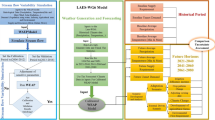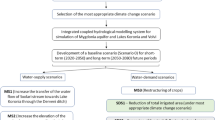Abstract
Climate as one of the key factors in water resources management affects the amount of water in the hydrological cycle, which subsequently impacts the level of water availability. Considering the challenges that the South Alborz Region, Iran is currently facing in supplying water for various consumers; in this study, the climate change adaptation scenarios are investigated for sustainable water supply and demand. This study uses a procedure in which five different adaptation approaches, under RCPs scenarios, were established using the WEAP model to assess the impacts of various adaptation strategies on increasing the balance between water supply and demand over current and 2020s accounts. The findings suggest an imbalance between supply and demand in the current situation with the greatest imbalance in domestic use while the minimum in the industrial sector. The results of assessing adaptive scenarios show that various scenarios have different effects on balancing the water supply and demand by different consumers; on the other hand, the scenarios that directly affect domestic water demand have the greatest effect on minimizing the gap between supply and demand in the region; therefore, the options for decreasing the population demand along with diminishing the losses in the domestic water distribution network are the most effective alternatives for balancing supply and demand under all of the climate scenarios. The findings of this research indicate that adaptive management with the focus on restricting demand helps actively management of water resources in the regions with scarce water resources.








Similar content being viewed by others
References
Abutaleb KAA, Mohammed AHE-S, Ahmed MHM (2018) Climate change impacts, vulnerabilities and adaption measures for Egypt’s Nile Delta. Earth Syst Environ 1–10
Ahmadaali J, Barani G-A, Qaderi K, Hessari B (2018) Analysis of the effects of water management strategies and climate change on the environmental and agricultural sustainability of Urmia Lake Basin. Iran Water 10:160
Al-Zubari WK, El-Sadek AA, Al-Aradi MJ, Al-Mahal HA (2018) Impacts of climate change on the municipal water management system in the Kingdom of Bahrain: Vulnerability assessment and adaptation options Climate. Risk Manag 20:95–110
Ashraf Vaghefi S, Mousavi S, Abbaspour K, Srinivasan R, Yang H (2014) Analyses of the impact of climate change on water resources components, drought and wheat yield in semiarid regions: Karkheh River Basin in Iran. Hydrol Process 28:2018–2032
Bagheri A, Hosseini SA (2011) A system dynamics approach to assess water resources development scheme in the Mashhad plain, Iran, versus sustainability. Proceedings of the 4th International Perspective on Water Resources & the Environment (IPWE)
Berredjem A-F, Hani A (2017) Modelling current and future supply and water demand in the northern region of the Seybouse Valley. J Water Land Dev 33:31–38
Carvalho-Santos C, Monteiro AT, Azevedo JC, Honrado JP, Nunes JP (2017) Climate change impacts on water resources and reservoir management: uncertainty and adaptation for a mountain catchment in northeast Portugal. Water Resour Manag 31:3355–3370
Doell P, Mueller Schmied H, Schuh C, Portmann FT, Eicker A (2014) Global-scale assessment of groundwater depletion and related groundwater abstractions: Combining hydrological modeling with information from well observations and GRACE satellites. Water Resour Res 50:5698–5720
Ebadi A, Toughani M, Najafi A, Babaee M (2020) A brief overview on current environmental issues in Iran. Cent Asian J Environ Sci Technol Innov 1:1–11
Foltz RC (2002) Iran's water crisis: cultural, political, and ethical dimensions. J Agric Environ Ethics 15:357–380
Garrote L (2017) Managing water resources to adapt to climate change: facing uncertainty and scarcity in a changing context. Water Resour Manag 31:2951–2963
Gleick PH, Heberger M (2014) Water conflict chronology. In The world’s water. Island Press Cent Resour Econ 173–219
Gohari A, Mirchi A, Madani K (2017) System dynamics evaluation of climate change adaptation strategies for water resources management in central Iran. Water Resour Manag 31:1413–1434
Hojjati MH, Boustani F (2010) An assessment of groundwater crisis in Iran, case study: Fars province World Academy of Science. Eng Technol 70:476–480
Hussen B, Mekonnen A, Pingale SM (2018) Integrated water resources management under climate change scenarios in the sub-basin of Abaya-Chamo, Ethiopia. Model Earth Syst Environ 4:221–240
Izady A, Davary K, Alizadeh A, Ghahraman B, Sadeghi M, Moghaddamnia A (2012) Application of panel-data modeling to predict groundwater levels in the Neishaboor Plain, Iran. Hydrogeol J 20:435–447
Jahani HR, Reyhani M (2006) Role of groundwater in Tehran water crisis mitigation. In International Workshop on Groundwater for Emergency Situations, Tehran 115–128
Kiparsky M, Joyce B, Purkey D, Young C (2014) Potential impacts of climate warming on water supply reliability in the Tuolumne and Merced river basins, California. PloS One 9:e84946
Madani K (2014) Water management in Iran: what is causing the looming crisis? J Environ Stud Sci 4:315–328
Malla MA, Ahmad UF, Rather MA, Teli MN, Kuchhay NA (2014) Assessing water demand and supply for Srinagar City (J&K) India, under changing climatic scenarios using water evaluation and planning model (WEAP). IJMER
Marin M, Clinciu I, Tudose NC, Ungurean C, Adorjani A, Mihalache AL, Davidescu AA, Davidescu ȘO, Dinca L, Cacovean H (2020) Assessing the vulnerability of water resources in the context of climate changes in a small forested watershed using SWAT: a review. Environ Res 184
Mehrazar A, Bavani ARM, Gohari A, Mashal M, Rahimikhoob H (2020) Adaptation of water resources system to water scarcity and climate change in the suburb area of megacities. Water Resour Manag 34:3855–3877
Metobwa OGM, Mourad KA, Ribbe L (2018) Water demand simulation using WEAP 21: a case study of the Mara River Basin, Kenya. Int J Nat Resour Ecol Manag 3:9–18
Mirdashtvan M, Najafinejad A, Malekian A, Sa’doddin A (2018) Downscaling the contribution to uncertainty in climate-change assessments: representative concentration pathway (RCP) scenarios for the South Alborz Range, Iran. Meteorol Appl 25:414–422
Pahl-Wostl C, Craps M, Dewulf A, Mostert E, Tabara D, Taillieu T (2007) Social learning and water resources management. Ecol Soc 12
Peel MC, Finlayson BL, McMahon TA (2007) Updated world map of the Köppen-Geiger climate classification. Hydrol Earth Syst Sci Discuss 4:439–473
Ravanshadnia M, Ghanbari M, Fardani MH (2015) Planning crisis management of water resources in Tehran in the next twenty five years. J Appl Environ Biol Sci 5:50–59
Santikayasa IP, Babel MS, Shrestha S (2015) Assessment of the impact of climate change on water availability in the Citarum river basin, Indonesia: The use of statistical downscaling and water planning tools. In Managing Water Resources under Climate Uncertainty. Springer, pp 45–64
Saraswat C, Mishra BK, Kumar P (2017) Integrated urban water management scenario modeling for sustainable water governance in Kathmandu Valley, Nepal. Sustain Sci 12:1037–1053
Sarzaeim P, Bozorg-Haddad O, Fallah-Mehdipour E, Loáiciga HA (2017) Climate change outlook for water resources management in a semiarid river basin: the effect of the environmental water demand. Environ Earth Sci 76:498
Sieber J, Purkey D (2011) WEAP user guide Stockholm Environmental Institute, US Center
Sieber J, Purkey D (2013) Water evaluation and planning system user guide for WEAP 21. Stockholm Environment Institute Tellus Institute, Boston
Soltani G, Saboohi M (2008) Economic and social impacts of groundwater overdraft: The case of Iran. In Paper Submitted to 15th ERF Annual Conference, Cairo, Egypt, pp 23–25
Vojdani F (2004) Efficiency in water planning and management (an implementation experience). Water Sci Technol Water Supply 4:67–80
Wang X-j, Zhang J-y (2017) Shamsuddin S, Oyang R-l, Guan T-s, Xue J-g, Zhang X. Impacts of climate variability and changes on domestic water use in the Yellow River Basin of China. Mitig Adapt Strateg Glob Chang 22:595–608
Yang D, Yang Y, Xia J (2021) Hydrological cycle and water resources in a changing world: A review. Geogr Sustain
Yates D, Sieber J, Purkey D, Huber-Lee A (2005) WEAP21–A demand-, priority-, and preference-driven water planning model: part 1: model characteristics. Water Int 30:487–500
Acknowledgments
The authors would like to appreciate the anonymous reviewers for their useful comments and suggestions.
Funding
This research received no funding.
Author information
Authors and Affiliations
Contributions
All authors contributed to the study conception and design, material preparation, data collection, analysis, and writing
Corresponding author
Ethics declarations
Conflict of Interest
The authors declare that they have no conflict of interest.
Additional information
Publisher's Note
Springer Nature remains neutral with regard to jurisdictional claims in published maps and institutional affiliations.
Rights and permissions
About this article
Cite this article
Mirdashtvan, M., Najafinejad, A., Malekian, A. et al. Sustainable Water Supply and Demand Management in Semi-arid Regions: Optimizing Water Resources Allocation Based on RCPs Scenarios. Water Resour Manage 35, 5307–5324 (2021). https://doi.org/10.1007/s11269-021-03004-0
Received:
Accepted:
Published:
Issue Date:
DOI: https://doi.org/10.1007/s11269-021-03004-0




